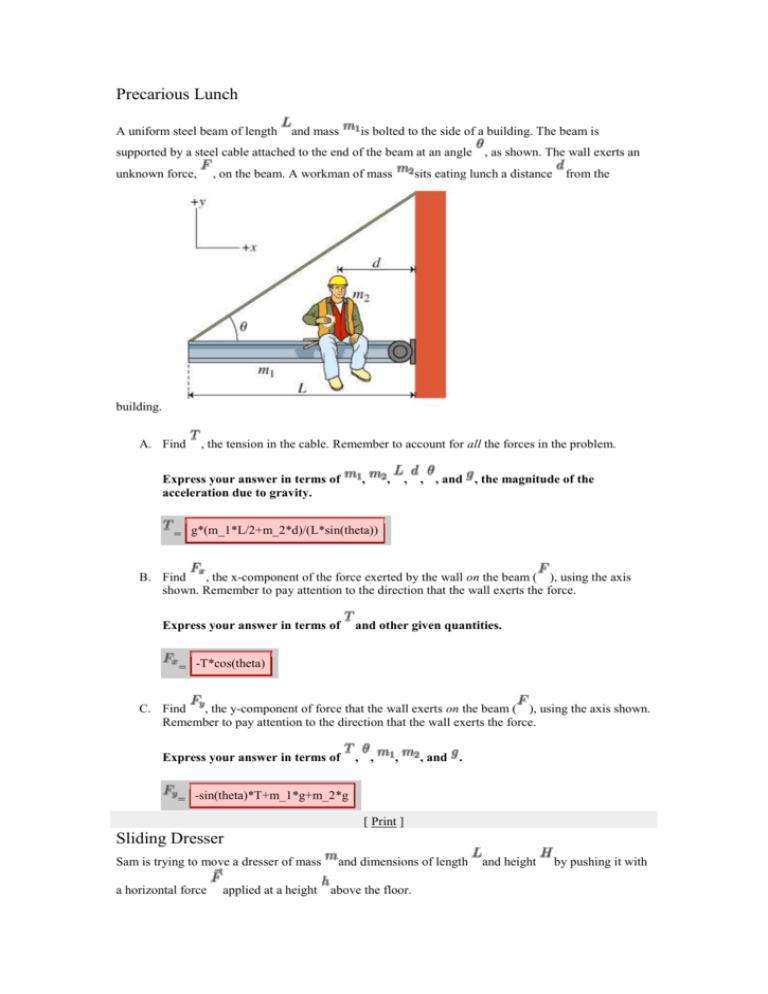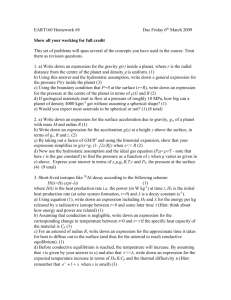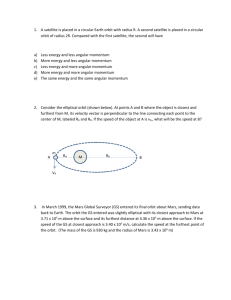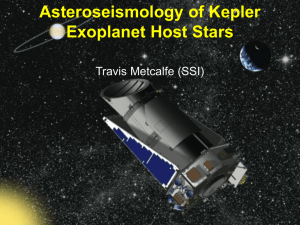Precarious Lunch
advertisement

Precarious Lunch A uniform steel beam of length and mass is bolted to the side of a building. The beam is supported by a steel cable attached to the end of the beam at an angle , as shown. The wall exerts an unknown force, , on the beam. A workman of mass sits eating lunch a distance from the building. A. Find , the tension in the cable. Remember to account for all the forces in the problem. Express your answer in terms of acceleration due to gravity. , , , , , and , the magnitude of the = g*(m_1*L/2+m_2*d)/(L*sin(theta)) B. Find , the x-component of the force exerted by the wall on the beam ( ), using the axis shown. Remember to pay attention to the direction that the wall exerts the force. Express your answer in terms of and other given quantities. = -T*cos(theta) C. Find , the y-component of force that the wall exerts on the beam ( ), using the axis shown. Remember to pay attention to the direction that the wall exerts the force. Express your answer in terms of , , , , and . = -sin(theta)*T+m_1*g+m_2*g [ Print ] Sliding Dresser Sam is trying to move a dresser of mass a horizontal force applied at a height and dimensions of length above the floor. and height by pushing it with The coefficient of and is the magnitude of the acceleration due to kinetic friction between the dresser and the floor is gravity. The ground exerts upward normal forces of magnitudes dresser. Note that this problem is two dimensional. A. If the dresser is sliding with constant velocity, find applies. Express the force in terms of , , and and at the two ends of the , the magnitude of the force that Sam . = mu_k*m*g B. Find the magnitude of the normal force . Assume that the legs are separated by a distance , as shown in the figure. Express this normal force in terms of , , , , and . = m*g/2-mu_k*m*g*h/L C. Find the magnitude of the normal force . Assume that the legs are separated by a distance , as shown in the figure. Answer in terms of , , , , and . = m*g/2+mu_k*m*g*h/L D. Find , the maximum height at which Sam can push the dresser without causing it to topple over. Express your answer for the maximum height in terms and . = L/(2*mu_k) A Person Standing on a Leaning Ladder A uniform ladder with mass and length rests against a smooth wall. A do-it-yourself enthusiast of mass stands on the ladder a distance from the bottom (measured along the ladder). The ladder makes an angle with the ground. There is no friction between the wall and the ladder, but there is a frictional force of magnitude between the floor and the ladder. is the magnitude of the normal force exerted by the wall on the ladder, and is the magnitude of the normal force exerted by the ground on the ladder. Throughout the problem, consider counterclockwise torques to be positive. None of your answers should involve (i.e., simplify your trig functions). A. What is the minimum coeffecient of static friction ground so that the ladder does not slip? Express in terms of , , , required between the ladder and the , and . = (m_1*d+m_2*L/2)*cos(theta)/((m_1+m_2)*L*sin(theta)) B. Suppose that the actual coefficent of friction is one and a half times as large as the value of . That is, of friction . Under these circumstances, what is the magnitude of the force that the floor applies to the ladder? Express your answer in terms of the relation of force and . , , , , , and . Remember to pay attention to = (m_1*d+m_2*L/2)*cos(theta)*g/(L*sin(theta)) Three-Legged Table The top view of a table, with weight , is shown in the figure. The table has lost the leg at ( , ), in the upper right corner of the diagram, and is in danger of tipping over. Company is about to arrive, so the host tries to stabilize the table by placing a heavy vase (represented by the green circle) of weight 0), ( at ( , , 0), and (0, A. Find ). Denote the magnitudes of the upward forces on the table due to the legs at (0, ) as , , and , respectively. , the magnitude of the upward force on the table due to the leg at ( Express the force in terms of , , quantities may appear in the answer. , , , and/or , 0). . Note that not all of these = W_v*X/L_x + W_t/2 B. Find , the magnitude of the upward force on the table due to the leg at (0, Express the force in terms of , , , quantities may appear in the final answer. , , and/or ). . Note that not all of these = W_v*Y/L_y+W_t/2 C. Find , the magnitude of the upward force on the table due to the leg at (0, 0). Express the force in terms of , terms may appear in the answer. = W_v*(1-X/L_x-Y/L_y) , , , , , , and/or . Note that not all While the host is greeting the guests, the cat (of weight ) gets on the table and walks until her position is . A. Find the maximum weight vase. of the cat such that the table does not tip over and break the Express the cat's weight in terms of , , , , and . = W_v*(1-X/L_x-Y/L_y) Young's Modulus Learning Goal: To understand the meaning of Young's modulus, to perform some real-life calculations related to stretching steel, a common construction material, and to introduce the concept of breaking stress. You are aready familiar with Hooke's law, which states that for springs and other "elastic" objects , where is the magnitude of the stretching force, is the corresponding elongation of the spring from equilibrium, and is a constant that depends on the geometry and the material of the spring. If the deformations are small enough, most materials, in fact, behave like springs: Their deformation is directly proportional to the external force. Therefore, it may be useful to operate with an expression that is similar to Hooke's law but describes the properties of various materials, as opposed to various objects such as springs. Such an expression does exist. Consider, for instance, a bar of initial length and cross-sectional area stressed by a force of magnitude . As a result, the bar stretches by . Let us define two new terms: Tensile stress is the ratio of the stretching force to the cross-sectional area: . Tensile strain is the ratio of the elongation of the rod to the initial length of the bar: . It turns out that the ratio of the tensile stress to the tensile strain is a constant--as long as the tensile stress is not too large. That constant, which is an inherent property of a material, is called Young's modulus and is given by A. What is the SI unit of Young's modulus? Pa or pascal or Pascal or pascals or Pascals or kg/(m*s^2) or N/(m^2) B. Consider a metal bar of initial length the material of the bar is strain. and cross-sectional area . The Young's modulus of . Find the "spring constant" of such a bar for low values of tensile Express your answer in terms of , , and . = Y*A/L C. Ten identical steel wires have equal lengths and equal "spring constants" . The wires are connected end to end, so that the resultant wire has the length of constant" of the resulting wire? D. Ten identical steel wires have equal lengths . What is the "spring and equal "spring constants" . The wires are slightly twisted together, so that the resultant wire has the length of and is ten times as thick as the individual wire. What is the "spring constant" of the resulting wire? E. Ten identical steel wires have equal lengths modulus of each wire is the length of F. and equal "spring constants" . The Young's . The wires are connected end to end, so that the resultant wire has . What is the Young's modulus of the resulting wire? Ten identical steel wires have equal lengths modulus of each wire is and equal "spring constants" . The Young's . The wires are slightly twisted together, so that the resultant wire has the length of and is ten times as thick as the individual wire. What is the Young's modulus of the resulting wire? G. Consider a steel guitar string of initial length and cross-sectional area . The Young's modulus of steel is would such a string stretch under a tension of 1500 N? . How far ( ) Use two significant figures in your answer. Express your answer in millimeters. = 15 mm H. Although humans have been able to fly hundreds of thousands of miles into outer space, getting inside the earth has proven much more difficult. The deepest mines ever drilled are only about 10 miles deep. To illustrate the difficulties associated with such drilling, consider the following: The density of steel is about and its breaking stress--defined as the maximum stress the material can bear without deteriorating--is about . What is the maximum length of a steel cable that can be lowered into a mine? Assume that the magnitude of the acceleration due to gravity remains constant at . Use two significant figures in your answer. Express your answer in kilometers. 26 km Escape Velocity Learning Goal: To introduce you to the concept of escape velocity for a rocket. The escape velocity is defined to be the minimum speed with which an object of mass must move to escape from the gravitational attraction of a much larger body, such as a planet of total mass . The escape velocity is a function of the distance of the object from the center of the planet , but unless otherwise specified this distance is taken to be the radius of the planet because it addresses the question "How fast does my rocket have to go to escape from the surface of the planet?" A. The key to making a concise mathematical definition of escape velocity is to consider the energy. If an object is launched at its escape velocity, what is the total mechanical energy of the object at a very large (i.e., infinite) distance from the planet? Follow the usual convention and take the gravitational potential energy to be zero at very large distances. = 0 Consider the motion of an object between a point close to the planet and a point very very far from the planet. Indicate whether the following statements are true or false. A. Angular momentum about the center of the planet is conserved. true false B. Total mechanical energy is conserved. true false C. Kinetic energy is conserved. true D. false The angular momentum about the center of the planet and the total mechanical energy will be conserved regardless of whether the object moves from small being launched) or from large true E. to small to large (like a rocket (like a comet approaching the earth). false Find the escape velocity center of a planet of mass air resistance. for an object of mass that is initially at a distance . Assume that Express the escape velocity in terms of constant. from the , the radius of the planet, and ignore , , , and , the universal gravitational = (2*G*M/R)^(1/2) [ Print ] Properties of Circular Orbits Learning Goal: To teach you how to find the parameters characterizing an object in a circular orbit around a much heavier body like the earth. The motivation for Isaac Newton to discover his laws of motion was to explain the properties of planetary orbits that were observed by Tycho Brahe and analyzed by Johannes Kepler. A good starting point for understanding this (as well as the speed of the space shuttle and the height of geostationary satellites) is the simplest orbit--a circular one. This problem concerns the properties of circular orbits for a satellite orbiting a planet of mass . For all parts of this problem, where appropriate, use for the universal gravitational constant. A. Find the orbital speed for a satellite in a circular orbit of radius Express the orbital speed in terms of , , and . . = sqrt(G*M/R) B. Find the kinetic energy of a satellite with mass Express your answer in terms of , , , and in a circular orbit with radius . . = G*M*m/(2*R) C. Express the kinetic energy in terms of the potential energy . = -1/2*U D. Find the orbital period . Express your answer in terms of , , , and . = 2*pi*R^(3/2)*(G*M)^(-1/2) E. Find an expression for the square of the orbital period. Express your answer in terms of = F. , , , and . (2*pi)^2/(G*M)* R^3 Find , the magnitude of the angular momentum of the satellite with respect to the center of the planet. Express your answer in terms of , , , and . = m*(G*M*R)^0.5 G. The quantities , depend on radius value of each. , , and all represent physical quantities characterizing the orbit that . Indicate the exponent (power) of the radial dependence of the absolute Express your answer as a comma-separated list of exponents corresponding to , and , in that order. For example, -1,-1/2,-0.5,-3/2 would mean and so forth. -1/2 , -1 , -1 , 1/2 , , , , Geosynchronous Satellite A satellite that goes around the earth once every 24 hours is called a geosynchronous satellite. If a geosynchronous satellite is in an equatorial orbit, its position appears stationary with respect to a ground station, and it is known as a geostationary satellite. A. Find the radius of the orbit of a geosynchronous satellite that circles the earth. (Note that is measured from the center of the earth, not the surface.) You may use the following constants: o The universal gravitational constant is . o The mass of the earth is . o The radius of the earth is . Give the orbital radius in meters to three significant digits. 4.225*10^7 (+/- 0.2%) or m = (5.98*10^24*6.67*10^-11 /(2*pi/(24*60*60))^2)^(1/3) [ Print ] A Satellite with Drag This problem concerns the properties of circular orbits for a satellite of mass mass orbiting a planet of in an almost circular orbit of radius . In doing this problem, you are to assume that the planet has an atmosphere that causes a small drag due to air resistance. "Small" means that there is little change during each orbit so that the orbit remains nearly circular, but the radius can change slowly with time. The following questions will ask about the net effects of drag and gravity on the satellite's motion, under the assumption that the satellite's orbit stays nearly circular. Use gravitational constant. A. The total mechanical energy of the satellite will __________. if necessary for the universal increase decrease stay the same vary in a more complex way than is listed here B. What is the potential energy of the satellite? Express your answer in terms of , , , and . = -m*M*G/r C. What is the kinetic energy of the satellite? Express the kinetic energy in terms of , , , and . = 1/2*m*M*G/r D. As the force of the air resistance acts on the satellite, the radius of the satellite's orbit will __________. increase decrease stay the same vary in a more complex way than is listed here E. As the force of the air resistance acts on the satellite, the kinetic energy of the satellite will __________. increase decrease stay the same vary in a more complex way than is listed here F. Which force or forces lead to a change in kinetic energy? That is, which force or forces do work on the satellite? gravity alone the drag force alone both the drag force and gravity G. As the force of the air resistance acts on the satellite, the magnitude of the angular momentum of the satellite with respect to the center of the planet will __________. increase decrease stay the same vary in a more complex way than is listed here H. Which force or forces will cause the magnitude of the satellite's angular momentum with respect to the center of the planet to change? gravity alone the drag force alone both the drag force and gravity Post-Collision Orbit A small asteroid is moving in a circular orbit of radius about the sun. This asteroid is suddenly struck by another asteroid. (We won't worry about what happens to the second asteroid, and we'll assume that the first asteroid does not acquire a high enough velocity to escape from the sun's gravity). Immediately after the collision, the speed of the original asteroid is relative to the radial direction, as shown in the figure. asteroid is , and it is moving at an angle Assume that the mass of the and that the mass of the sun is , and use for the universal gravitation constant. Since the asteroid does not reach escape velocity, it must remain in a bound orbit around the sun, which will be an ellipse. Take the following steps to find and , the aphelion and perihelion distance of the asteroid after the collision. (The aphelion is the point in the orbit farthest from the sun, and the perihelion is the point in the orbit closest to the sun.) As in most orbit problems, the most fundamental principles involved are energy and angular momentum conservation. A. What is the total energy of the asteroid immediately after the collision? Express the total energy in terms of , , , , , and . = 0.5*m*V_0^2-G*M*m/R_0 B. What is , the magnitude of the angular momentum of the asteroid immediately after the collision, as measured about the center of the sun? Express the magnitude of the angular momentum in terms of , , , , , and . = m*V_0*R_0*sin(theta) , , and are given initial conditions, and the values of , , and are known constants. The total energy and angular momentum may be expressed entirely in terms of these known, fixed quantities. This means that we should be able to express any of the fixed quantities related to the new orbit in terms of , , and known constants, instead of using the initial conditions. Now focus on the new orbit of the asteroid. The final goal is to find and , the perhelion and aphelion distances of the new orbit, in terms of , , and known constants. Let orbital speeds at aphelion and perihelion respectively. and be the A. Write an expression for the total energy at aphelion in terms of the variables characterizing the motion there (i.e., and ). Express your answer in terms of , , , , and . = 0.5*m*V_a^2-G*M*m/R_a B. What is the magnitude of the angular momentum of the asteroid at aphelion? Express the magnitude of the angular momentum in terms of , , , , and . = m*V_a*R_a The total energy and angular momentum of the asteroid at perihelion are obtained by replacing and with with in the equations just derived. Instead of considering aphelion and perihelion separately, let's consider them simultaneously by replacing and with the generic symbol , and replacing and with the generic symbol , where the subscript "e" stands for extremum (since aphelion and perihelion are the extrema of the orbit). The reason for doing this will become clear in a moment. A. Write an expression for . Express your answer in terms of , and , the known quantity , and the fixed constants , . = L/(m*R_e) B. Find a quadratic equation of the form quantities , , , , and , , and to the known . Express your answer in terms of constants term is 1. that relates , the known quantities and , and the fixed . Construct your equation such that the coefficient of the 0 = R_e^2+(G*M*m/E)*R_e-0.5*L^2/(m*E) C. The quadratic you have just derived, , has two solutions: One will correspond to the reason for using the generic symbol , and the other will correspond to . Solve for . This was using the quadratic formula and find (the larger root). Remember that must be negative, which means that the term in the quadratic equation is positive. (This is to be expected since the results should give radii, which need to be positive.) Express the distance at aphelion in terms of fixed constants your answers. , , and , the known quantities and , and the . The results are a bit messy, so be careful when typing in = 0.5*(-G*M*m/E+sqrt((G*M*m/E)^2+2*L^2/(m*E))) D. Now solve your quadratic equation to get the perihelion distance = 0.5*(-G*M*m/E-sqrt((G*M*m/E)^2+2*L^2/(m*E))) (the smaller root).







